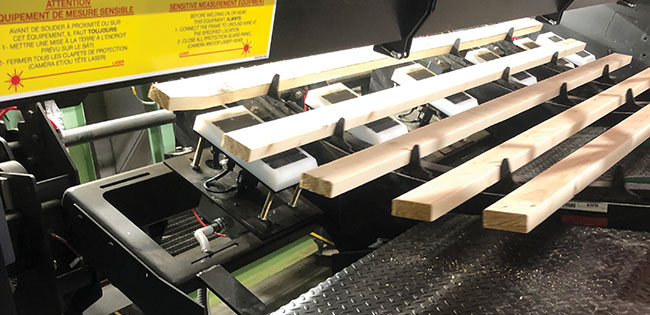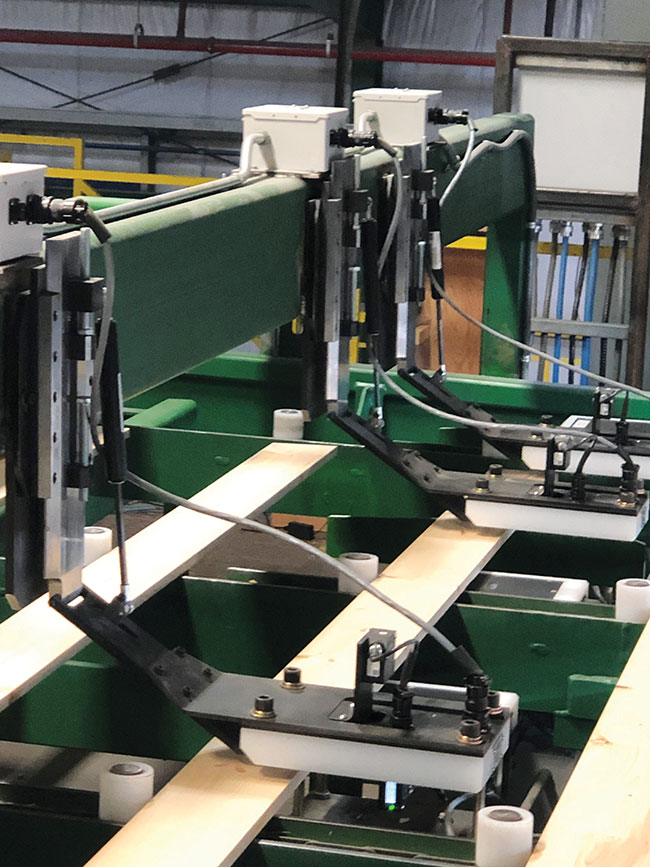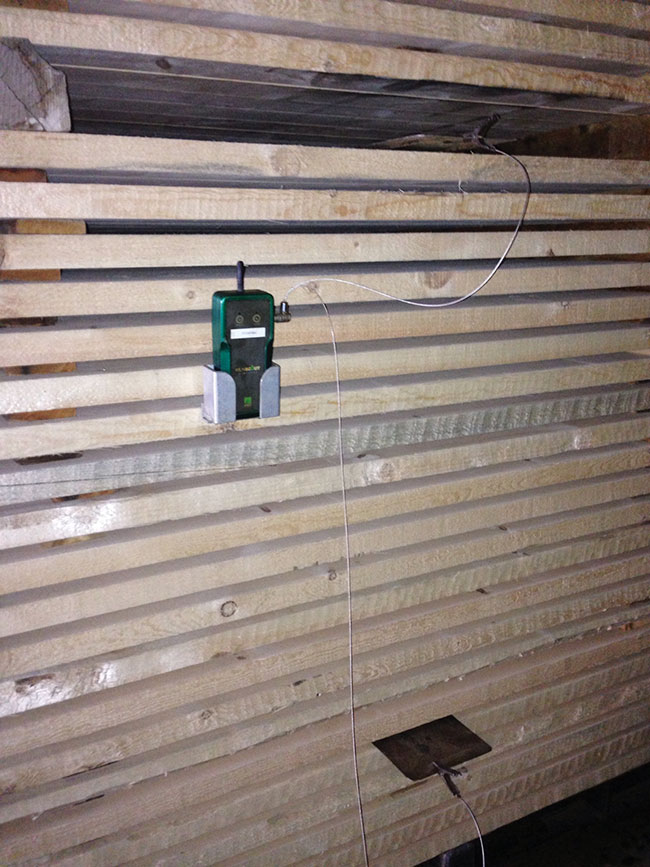
Features
Equipment
Sawmilling
The ultimate guide to lumber moisture control
February 24, 2021 By Stuart Harries and Steve Maurer
 High-definition planer systems are providing more moisture mapping options for detecting wet conditions.
High-definition planer systems are providing more moisture mapping options for detecting wet conditions. Moisture affects every phase of lumber manufacturing – the sawmill, kiln and planer. However, where uncontrolled moisture once contributed to significant waste, mills can now reduce or eliminate losses, as well as improve productivity. This is done by a synergy of advanced moisture sensor hardware and software that makes sense of the data, by utilizing the Industrial Internet of Things (IIoT). Using this combination, mills can gain control over moisture to improve product quality, from the last cut of the trimmer all the way to the customer’s door.
The sawmill
The sawmill is the first opportunity in lumber processing to recognize benefits from advanced moisture sensors. Designed to optimize lumber recovery, sensors give sawmills the necessary tools to quickly identify and sort boards after primary breakdown.
This data-driven sorting is critical to achieving the best grade recoveries at the end of the production process. Dunkley Lumber’s process control manager, Lee Mason, agrees with this assessment.
“The most important part of our drying program is the sorting of wet and dry lumber after primary breakdown,” he says. “Sorting allows us to capture more value from the fibre due to less downgrade for being too dry, or too wet.”
Lumber’s natural variability
When mills effectively control the natural variability of lumber, they improve the balance of cost and time that represents their ultimate profitability measure. Sorting after primary breakdown lets mills manage the complex issues of forest biodiversity such as multiple species, varying log sizes and different conditions. Some logs or boards in the North may be frozen, and in the South, they may be subject to mould, staining or end-checking.
“Our mills are in northern Canada, and our Finna Sensors High Definition (HD) system reacts well to temperature fluctuations,” Mason says. “We also see improved kiln efficiency by reducing our drying times on the drier sorts.”
For mills where moisture sensing is not a parameter for optimization, the resulting lumber is often prone to large standard deviations in moisture content. These deviations will typically miss the desired moisture target and decrease the mill’s productivity by consistently delivering a significantly higher volume of wet lumber and over-dried boards.
The latest moisture systems on the market help more mills avoid these costly drying errors and make more profitable products. They go beyond simple species sorts to deliver robust data that determines critical considerations, like variations within a single species, to ensure more uniform packages for kiln drying and improved grade recovery at the planer.

High-definition sawmill moisture systems can now be positioned to read the top and bottom of boards for more accurate sorting.
Moisture sensor advancements
Moisture sensors in the sawmill are added at the end of the production line to improve production bottlenecks at the kiln and grade recovery in the planer. In the past, moisture sensors touched the boards using a contact system that measured both faces. However, this approach required additional ongoing maintenance because of the system’s full contact nature.
Addressing these concerns, Finna Sensors developed the Sawmill Green Lumber Sorting System to be more robust and non-contact. It avoids continuous maintenance, while providing up to five sensors beneath the line, to deliver processing data for up to a 20-foot board.
But, as mills required even more in-depth data to increase profitability and reduce waste, moisture sensors have also advanced. Today, the most modern mills are benefitting from HD moisture systems. These sensors can be specified to fit between chain runs and be positioned to read both the top and bottom faces of boards. This substantial increase in surface-area readings can help operators identify the boundaries of heartwood/sapwood, or the areas of wet pockets to improve pre-kiln sorting. Consequently, it can help realize double-digit productivity increases and enhanced lumber recovery.
“We currently have two Finna Sensors HD systems in our mills: they are built strong, easy to maintain, and don’t impede the flow of wood due to their non-contact design,” Mason says. “The payback in each mill took less than a year.”
The future
Payback matters and the latest moisture sensors are continuing to improve the profitability of mills.
The next generation of advancements when it comes to moisture control is already combining the best measurement options from previous technology wins.
Now, modern mills can opt for a hybrid sawmill system that seamlessly combines moisture measurement technologies, including bulk density, radio frequency and species inputs to deliver even more data points. This data, when combined with advanced software and IIoT connections, is the future of data-driven sorting.
The Kiln
Integrating moisture sensor advancements at the kiln is the smartest technical solution to achieving improved productivity and ensuring quality throughput to the next stage. By using real-time data to plot the correct mix of temperature control, air flow and relative humidity, mills can reduce or eliminate problems such as wet claims, checks, warping, and unnecessary transportation costs due to excess water weight.
West Fraser’s thermal energy supervisor, Martin Andres, has been with the company for more than 42 years, and knows the importance of moisture control in kiln drying as well as anyone.
“With wets, you will obviously get claims,” he says. “Even though we don’t get a claim for over dries, it degrades the wood, and you’ll end up with more end and surface checking. The lumber shrinks just that much more, so you end up with skip on your wood.”
This understanding of how wood dries is crucial to developing effective drying schedules, and it underscores the ongoing development of kiln sensor and software advancements.
Drying innovations
To start, Finna Sensors developed their own wired radio frequency (RF) sensor technology for batch kilns. These sensors use RF to determine capacitance, another method of determining moisture. Plates are non-invasively inserted between the stickers. With a plate near the top of the stack and the other near the bottom, a more representative value of the entire charge package is possible. Especially with southern yellow pine, the variability of guessing when to shut down was removed.
With the advancement of continuous dry kilns (CDKs) came a new generation of sensors – this time wireless. For example, Finna Sensors was the first to develop a wireless RF sensor system, called KilnScout-Wireless. With no cables to tie them down, the sensors travel with the charge. These sensors also integrate with the kiln controls for either manual or automated operation. Up to 100 sensors per kiln can be used to monitor moisture and temperature settings, giving the operator a more complete view of what is going on inside the kiln, and the opportunity to adjust the schedule accordingly.
“At a particular division, we were in need of replacing aged control equipment so we evaluated the [RF sensors] to ensure they would provide the right moisture content,” Andres says. “So far, we have experienced time savings and consistent results using the moisture-sensing system. We have not had wet lumber since it was installed.”
With the data-capturing system integrated with the controls, there is another potential benefit. Using kiln systems connected to each other via network or Internet, multiple kilns can be monitored and controlled from one location, also helping to offset the lack of experienced operators.
According to Tony Nadeau, Sechoir MEC’s dry kiln automation and control director, “We worked with a customer that bought kilns for two different sites. We installed KilnScout systems for each kiln with eight sensors per system. MEC’s sensor system was modified so the customer was able to monitor both sites from one location. The RF sensors and data collection units allowed the mill to monitor and modify the drying schedule for each kiln.”
Making necessary modifications is easier than ever before. Thanks to built-in monitoring and connectivity through IIoT, along with predictive maintenance features, operators can be notified of upcoming issues, such as low battery strength, and take action.
But moisture sensing and process integration improvements do not just end at the kiln. After drying, the planer becomes the last chance to realize maximum productivity and profit.

Using capacitive measurement, KilnScout allows operations to control the drying process from direct moisture content input.
The Planer
Once kiln-dried lumber reaches the planer; mills have a final opportunity to optimize board moisture before their product is shipped. Using moisture sensors, mills can utilize their planer to improve overall productivity, enhance grade recovery and reduce, or even eliminate, wet claims.
Ultimately, planer moisture systems have been developed to help mills manage difficult cost and productivity issues. For instance, sensors can alert operators when too many wet boards arrive at the planer. This gives the mill a chance to make a value decision using real-time data, and the opportunity to back the boards out for re-drying, or to move forward and accept the economics of lower-grade values.
When lumber arrives too dry, the mill can mitigate the impact. Over-dried lumber can affect productivity and increase hard costs, as twist and warp hold the potential to jam machinery and damage blades. The downtime to stop a run and perform maintenance is lost money for the mill.
Also, if dry boards become wet again, operators need to know if it’s surface or core moisture. By the time lumber goes mouldy or stains, it’s too late, and the value is lost.
It’s these kinds of advanced moisture sensors that Canfor southern pine quality control tech, Shaw Bennett, uses to better manage planer output. And his results go beyond improved grade recovery.
“Before [upgrading to a planer moisture] system, we used to have packs on hold from our inspection agency due to wet lumber, but this has not been an issue since installation,” Bennett says. “It has helped us prevent Low E Values caused by too much moisture in boards.”
Moisture and the planer
Eventually, all the work of the sawmill and kiln is technically evaluated at the planer. Now, automatic grading systems can apply moisture as a parameter of classification using data provided by non-contact moisture sensors. This allows the results of drying to be more easily quantified, and for lumber to be more effectively classified into grades.
But, before automatic grading integration, it wasn’t so easy. Lumber went through a moisture metre and, if the wood was wet, it was sprayed with a paint marker that a manual grader would eventually see. The manual grader would then classify the board as Economy, instead of Prime or #2 & Better.
The next generation of transverse moisture metres began to improve data readings and provide more robust information; mills immediately realized an increase in grade recovery. These sensors use capacitive technologies to take multiple readings per board and then deliver automatic data hand-offs for grade optimization by machine.
With data provided by transverse moisture metres, such as the Finna Sensors Transverse Planer Moisture System, mills can also consider choosing to drop out wet boards before they are dressed, allowing them to be re-dried at nominal size. Strategic dropouts avoid grade reduction and wet claims.
Today, the latest generation of HD moisture systems are providing even richer moisture mapping capabilities. Using smaller sensors that are placed more frequently, and positioned on both sides of the board, HD technology is emerging as a solution for surface and/or core wet determination.
HD technology complements resolution for the latest versions of laser and scanning sensors associated with automatic grading decisions. This provides easy optimizations for product sales into engineered wood product markets such as finger joints and cross laminated timber.
Correlating data
The most accurate and successful mills will be using real-time moisture data to drive better lumber production from sawmill to kiln to planer. This data sets up on a correlation created across three determined data points: the handheld metre of the grading agency, the handheld metre of the mill, and the automated moisture sensing systems installed at the mill. It is a correlation that allows mills to reliably reach desired moisture content expectations for their end products.
Integrating moisture sensors lets mills achieve their biggest benefits by tracking, capturing, analyzing, and responding to the real-time moisture data developed across all areas of the lumber milling process.
“For us, having the MC Pro 2400 HDNC system has helped limit the amount of over-dried lumber and wet lumber,” Bennett says. “This has not only helped our production, but also our grade out.”
Future of planer moisture
Thanks to ongoing advancements in moisture-sensing technology, lumber mills find savings in grade recovery at the planer. They also see marked improvements in productivity.
Not that long ago, an operator would have to stop the line and change system sensitivity when the board size changed. Today, that old technology has been replaced by improved sensor sensitivity and software integration that takes care of productivity changes automatically.
The biggest benefit of moisture sensing is realized when mills capture, analyze and respond to their real-time moisture data across all areas of the process. That is when process integration and active IIoT connections provide their most impactful improvements using real time, data-driven moisture sensor systems.
Stuart Harries and Steve Maurer are technical writers living in Vancouver, B.C. and the United States, respectively.
Print this page